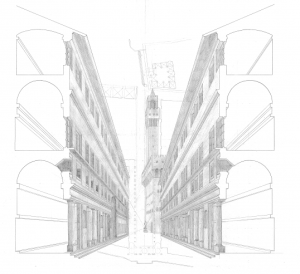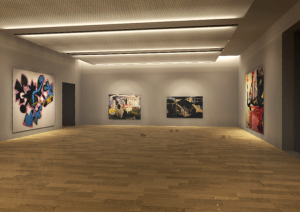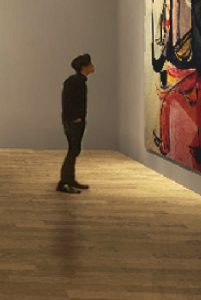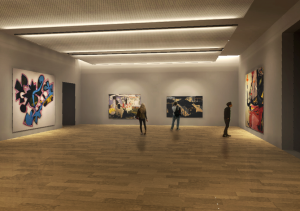A topic that I find really interesting is the idea of color. I have always just assumed that every physical object in this world obtains the colors we see. I have never really thought about the fact that color, including many other aspects of the world, is something that is actually psychophysical, and not just physical. The colors that we see are actually there because of the wavelengths of objects that are reflected by those colors. Surfaces have light reflected off of them differently. None of that technical stuff comes to mind when looking around in the world, because what we see just comes easy to us. Just like humans have brains that give them the ability to see the wavelengths of color, different animals have certain abilities that make them perceive the world differently. For example, bees can see ultraviolet light, which can attract them to the area of the flower where they need to pollinate. Fire flies can see through bioluminescence, and this feature helps them attract mates. They certainly do not see the colors humans see. This proves that in fact, what humans see, is not necessarily what is right, it is just what we perceive that helps us survive efficiently. Another really interesting aspect to color is how light and dark makes us perceive colors differently. When lights are shut off and you are looking at objects, we cannot see colors. Nothing has changed of the physical property of the object, or the wavelength that is being reflected. But, since we use rods in the dark, not cones, our rods only have one kind of photopigment molecule. Therefore, we can not differentiate between colors in the dark. It’s very interesting to me that even when sitting in the dark, the actual colors that we would see in the light are still present.
Monthly Archives: April 2014
Hearing Loss and Rock Concerts
When i was a Junior in high school, i spent a good majority of the winter and spring touring the east coast with a group of 20 other kids my age, playing classic rock concerts everywhere we went. When i first got on stage, with amplifiers stacked behind me turned up to the highest volume and a drum set with microphones in or around every drum or cymbal, the loudness or intensity of the sound was a little overwhelming. I mostly sang when i was on stage, and it can be difficult to hear yourself when so much other noise is around you. The first time i performed on stage, i was blown away by the other instruments and i couldn’t stay in the right key or sing the right pitch. My ears became desensitized over time, and i adapted to be able to control my voice despite the roaring guitars and ground-shaking drums
In February of 2009, we went on stage with Napolean Murphy Brock, whom most of you are probably unfamiliar with. He played jazz flute and the saxophone for Frank Zappa and the Mothers of Invention, a progressive rock band. He was an experienced musician, and i sought to learn from him while performing together. At the first show we played together, i noticed he was wearing earplugs, and asked how he could handle dulling the band’s sound so much to his own ears while still putting on a good show. He told me if i didn’t where ear plugs, i would be deaf in 20 years of putting on loud concerts. Phil collins is a famous musician who thrived in the 70s and 80s, and put on shows until he was almost 60-years-old. In 2011, he announced he would never again be performing on stage, because he could go completely deaf if he suffers any more hearing damage.
I spoke to my father, who was a music guru as a young adult, and he told me about how he has a constant ringing in his left ear that never goes away. He went to a performance by The Who in 1979, who were widely renowned for how loud their shows were, and was standing in the second row, on the far left side, directly next to a giant speaker. He said the ringing started after that show, and he has had hearing problems ever since. I first noticed my father’s hearing impairment when i was boiling water in a tea kettle, and walked outside onto my deck to shovel snow. I heard the tea kettle whistle, and ignored it because i figured my father would remove it from the hot stove for me. After a couple minutes, the whistling did not end, and i walked inside to see my dad watching sports in the same room as the stove. I asked him if he could hear ‘that’, and he replied, ‘hear what?’ The pitch at which the tea kettle whistled was the same as the ringing in his ear that does not go away. I was astounded that he could not hear the piercing sound, and promised myself i would never let my hearing get that bad.
I began to wear earplug whenever i performed, and despite not getting the full effect of hearing each song we played, it did not impair my ability to sing, and more importantly did not damage my hearing. In class we discussed the poor hearing of our generation, mainly attributed to the widespread use of ear buds, but loud shows can have the same detrimental effect on one’s hearing. Whether you are on stage or in the crowd watching, it is very important to wear earplugs during the louder performances, because it reduces the impact of soundwaves entering the ear and prevents damage to the Stereocilia within the inner ear which are very precious. Stereocilia cannot be regenerated, and excessively loud noises will destroy them.
Take good care of your ears, because your hearing becomes worse each and every time your stereocilia are damaged or destroyed. Neil young, Pete Townshend of The Who, Eric Clapton, and Jeff Beck of The Rolling Stones, all have permanent damage to their hearing, and will tell you time and time again that they wish they had worn earplugs on stage.
Fishing Boats by the Shore in a Calm

“Fishing Boats by the Shore in a Calm” (ca. 1660–65) Oil on canvas by Willem van de Velde the Younger (1633–1707)
This is one of my favorite paintings from Legion of Honor, for I always have this obsession with paintings of boats and ships. Willem van de Velde the Younger used many cues to give depth perception to this painting. One being occlusion, I can tell that the two boats on the far left seem to be parallel together, and the first boat is in front of the second boat because the first boat appears to be closer to where I am, and the second boat is further away from me. I also know that all the boats are about the same size based on my knowledge. This is the familiar size cue, even though some boats appear to be way smaller, some bigger, I still know that they are approximately the same size. So are the people in the painting, I know that they are about the same size as well, the two people near the tent are not x5 larger than those on the boat on the far back based on my knowledge. Another cue present in this painting would be aerial perspective, the fainter and the lighter color on the sky indicates that it is further away from me because the distance between me and the object of the background is further. And the bolder colors tell us that it the object is closer to me. Texture gradient tells me that the closer the objects are, the more details I can see. Therefore, I am able to see more details of the first boat that is closest to me than the ones that are further away from me.
Image source: http://www.sfgate.com/art/article/Dutch-and-Flemish-masterworks-at-Legion-of-Honor-2355389.php
Attention to Detail
What is attention? Seems like a simply question doesn’t it? However, no one can seem to give us a definitive answer. It is an arbitrary concept that our brain has seemed to master in order to take in information from our world. Most people think that they can attend to the whole environment around them and that they have a very vivid understanding of the world. Unfortunately for us, this is not true. Our attention is limited to only things that fall in the range of the fovea. Everything else is based on assumptions made by the brain. The reason we believe we can attend to everything is based on our ability to switch our attention from one thing to the next. We had several in class examples to show this. There were the videos where entire buildings were changed slowly but no one noticed until we looked at the original image. There were the gifs of pictures where one element changed. Even after watching the change right in front of us for 5 mins, it still had to be announced before everyone let out an audible “ooohhh!” It is both amazing and a little scary to think that we can miss things that are blatantly taking place right in front of us. It can make one wonder what else are we missing in our everyday life?
Tuning Timpani
Starting in fourth grade and ending in tenth grade, I spent several days a week at our school’s concert band practice. I was a percussion player and that meant learning new and interesting instruments on a regular basis. I had grown up playing the piano which made me one of the few drummers who could quickly sight-read musical notes while playing mallet instruments like the marimba. The keys on a piano are very similar to most mallet percussion instruments.
When I moved on from middle school to high school I had the opportunity to play a new instrument, the timpani. These are very large drums that sit on the floor with the head of the drums at the height of most people’s waist. The drums are tuned using a pedal at their base. The pedal stretches the head of the drum and creates different sounds. The interesting part about tuning the timpani was matching the pitch of the drum to that of a specific note required for a song. While other instruments would be warming up for a song, I would be using a pitch pipe to dial in the notes required on each drum.
When I was matching the pitch of the drums to the pitch pipe, I was actually just comparing their perceived frequencies. Many people can relate to pitch: low frequency sounds have a low pitch and high frequency sounds high pitch. A low pitch would be the sound you hear from a large drum, while a higher pitch would be a note played on a flute. Playing around with the tension in the head of the drum changed the physical movement of the head when hit with a mallet, and that changed the pitch that I was hearing.
The actual movement that takes place when a musician strikes a drum head is what creates a sound. The head moves up and down rapidly, creating changes in air pressure that follow a sinusoidal wave. This wave is commonly known as a sound wave. The frequency of the wave is perceived as pitch. The amplitude or intensity of the wave is perceived as loudness. A higher amplitude wave will produce a louder sound for the audience.
So it turns out that the entire time I was messing around with the tuning pedals on the timpani, I was really playing with the basic physics of creating sound.
What’s your favorite color?
What’s your favorite color? As a typical elementary school question to determine whether you’re truly compatible with your best friend or not, it always amused me how so many people had different answers. Ever member in my family, as well as my friends seemed to have a specific color they favored. Even at a young age I craved logic and definitive relationships, so I came up with a theory. I determined that we all actually had the same favorite color, but we perceived them differently. The same way that we discussed in class that color is a psychophysical relationship between the physical stimulus and our cognitive perception, I believed that we all had the same physical stimulus but different perceptions. My theory in practice stated that both my sister and I favored the same physical stimulus but societal practice categorized my favorite color as yellow and hers as green. This ideal is similar to our class discussions on color perception in terms of cultural relativism, in which color perception may be determined partly due to our cultural environment. However, has I have grown up and learned more about the biological aspects of color perception I realize that my theory was flawed. At the root of sensational and perceptional psychology is the understanding that specific environmental stimuli interact with certain anatomical structures to produce a specified neurological response. The developed theory of trichromacy has experimentally shown that colors of certain wavelengths interact with specific cone cell photoreceptors meaning that my theory is anatomically not possible. Despite the error in my original childhood theory, there are instances in which color is not uniformly perceived. Colorblindness, as discussed, is an instance in which differences in cone photoreceptors produce different color perception experiences. As proposed in the triochromatic theory, there are three cones (L, M and S) that are involved in color perception, each with a specific wavelength that they maximally respond to. The absence of one type of cone is called color anomalous. This defect is often typical for L and M cones which share a large overlap of perceived wavelengths, resulting in difficulty distinguishing between colors. This type of defect provides the only scientific reasoning for my original theory, as an individual with color anomalous could mislabel a color due to perception. A variety of other colorblind defects exist with the absence of only one cone, which skews color perception. These defects are as follows: deuteranope (absence of M cones, red-green color blind), protanope (absense of L cones, red-green color blind) and tritanope (absense of S cones, blue-yellow colorblind).
If you are interested in experiencing colorblindness, the following links are to colorblindness generators that will vary the images depending upon the absence or presence of cone types.
http://www.webexhibits.org/causesofcolor/2.html
http://www.colourblindawareness.org/colour-blindness/colour-blindness-experience-it/
Architectural Visualization
Selling architecture can be hard. An idea has to travel from your creative ideas, to sketches, to computer aided drafting, to structural engineers, to HVAC engineers, to electrical engineers. The list can go on and on. Your architectural forms and functions has to be integrated into multiple disciplines that have their own agendas. Then, finally, it can be brought to the client for their approval. And since the client is usually not familiar with architecture, building systems, construction, they need a lot of help visualizing the final result. This is where architects use visualization techniques to sell their designs. They create pretty pictures that look realist to put the client into their world that they’ve created. And they create these pictures using many depth cues found in visual perception.
This past year, I had to create these pictures for my final thesis project. I noticed I was using a lot of the same techniques found in PSYCH 253. So I thought I’d share some of my iterations in my process and how they relate to the depth cues.
A little background on the images to follow: I am redesigning the lighting for a contemporary art museum. The space I will be going through is an art gallery. All of these added depth cues were done in Adobe Photoshop.
Base Rendering:
Increased contrast and color corrections:
Overlays added: The depth cue aerial perspective is somewhat used here. I added a white overlay to the back of the room which makes it a little hazy and creates a feeling of depth.
Fabric added to ceiling panels: This uses the depth cue of texture gradient. I transformed the perspective of the texture image into finer and finer detail, fading off towards the back of the room to add depth.
People were added: Adding people uses relative height, occlusion, as well as shadows or shading depth cues. You can see the guy below was transformed to a height relative to the paintings around him, he is occluding further objects, and he casts a shadow around him.
Final image: You can see a lot of different techniques were used to add the feeling of depth and realism from the original picture.
A Euclidian vs non-Euclidian World
While the world around us is constructed with parallel lines running parallel, our eyes never see it that way. What we see on our retina and what is actually there before us are extremely different. Euclidian geometry represents the idea that two parallel lines will stay true to form and remain parallel as they extend into space and is a representation of the real world (Wolfe). What our retina sees though is non-Euclidian in nature and results in parallel lines extending to a common vanishing point. So a drawing using Euclidian geometries is accurate in an object’s actual construction but would never be seen in that same manner by our eyes and in a sense creates a false image.
For my freshman year in architecture I had a class that was entirely focused on accurately hand drafting architectural elements. Throughout the class we did a series of projects that focused on drawing Euclidian shapes and using Euclidian geometries to portray buildings but also did drawings that were non-Euclidian in nature and more focused on the perspective that would also be seen from a person at the building. From an architectural standpoint there are advantages to both types of drawing even though we only perceive one way.
The first drawing below is of Adolf Loos’ Rufer House in Vienna, Austria. This was drawn using Euclidian geometry to give a true sense of the space and accurate dimensions of every element within it. Even though the building would never be seen this way it can accurately portray the buildings true proportions.

 [Image Credit http://www.greatbuildings.com/cgibin/gbi.cgi/Rufer_House.html/cid_20051213_kmm_img_7989.html]
[Image Credit http://www.greatbuildings.com/cgibin/gbi.cgi/Rufer_House.html/cid_20051213_kmm_img_7989.html]
This second drawing uses non-Euclidian geometries to represent what a person would experience if they actually visited the building. The drawing below is of the Palazzo Vecchio from the entrance of the Uffizi in Florence, Italy. If you were to actually visit the Uffizi then the normally parallel lines of the building would appear to converge on a vanishing point at Michelangelo’s David due to the monocular depth cue of linear perspective.
 [Image Credit http://miriadna.com/preview/uffizi-gallery-(florence)]
[Image Credit http://miriadna.com/preview/uffizi-gallery-(florence)]
While we may only experience the world from a non-Euclidian perspective, and the world is actually constructed from Euclidian geometries, both forms provide us with a representation of the world around us. As an architecture student it is useful to perceive the world in both ways to get a better sense of space even though our eyes only let us view it from a non-Euclidian perspective.
Works Cited
Wolfe, Jeremy M., Keith R. Kleunder, and Dennis M. Levi. “Sensation & Perception: Eye Structure.” Sensation & Perception: Eye Structure. N.p., n.d. Web. 17 Mar. 2014.
Creating depth
Because one of my passions is art, I constantly relate the things I learn in this class to drawing concepts. At first I was surprised that there was so many similarities and overlaps but the more I thought about it the more sense it made: this class is, essentially, all about seeing. Art is (generally) about looking. In my last blog post I wrote about geons and how they relate to art but in this one I’m interested in the concept of depth. We have pictoral depth cues, which is when 3-D worlds are projected onto 2-D surfaces. How do artists create depth in art? By mimicking the way the eye perceives depth. Occlusion is one of the easiest ways to create depth when drawing or painting. Because the eye automatically perceives the occluded object to be further away or behind, it’s a simple way to create the illusion of depth. A lot of the things artists do in creating depth are less about specific artistic techniques and more about automatic reactions: we don’t consciously think about the fact that smaller objects look farther away or occluded objects look more distant. But as I draw I know that these are essential things to do if I want the picture to make sense spatially.
One of the most important, basic elements of trying to artisitically create the illusion of depth is linear perspective. One of the first things an artist should do when they begin a piece is find their vanishing point. Once those parallel lines are on the paper, it’s a matter of making sure everything you draw follows those lines. While drawing, the diminishing lines guide me in terms of how big or small whatever I draw should be. We learned about anamorphosis, which is purposefully distorting something so it only makes visual sense when viewed at a certain angle. This is something that a lot of artists do and I’ve used this technique a few times myself. But it’s very difficult because before you try to distort depth you have to already know how to create it normally.
Depth Cue picture
I have a picture in my room that I never really thought to much about until this post. It has almost all of the depth cues which we learned about in class in the picture. The picture is of my brother and I standing outside of my house that was drawn by an artist. The first cue that I noticed was occlusion. The house was obviously behind my brother and I because you could see our whole bodies, but not the whole house. Part of the house is blocked by us and also trees that are between us and the house. The next cue I noticed when looking at the picture was linear depth cue. You could see the river behind the house meeting with the horizon and all the rest of the picture kind of going to one spot where it looks to all vanish. The third depth cue I saw in the picture was atmosphere perspective. You could see that the sun which was closer to the horizon looked much farther away than the house or my brother and I. The clouds were higher up in the sky making them look closer. Under the horizon you can see the river which is very close to it and the water looks like it is going very far out while the trees which are drawn lower in the picture seem to almost stick out more. Other obvious depth cues that were in the picture were familiar size. You know how big a person is compared to a house or even compared to the river. We looked bigger because it was the main part of the picture making the house and river behind us look much smaller. You can find these depth cues in almost all of the pictures you will see in your life.






